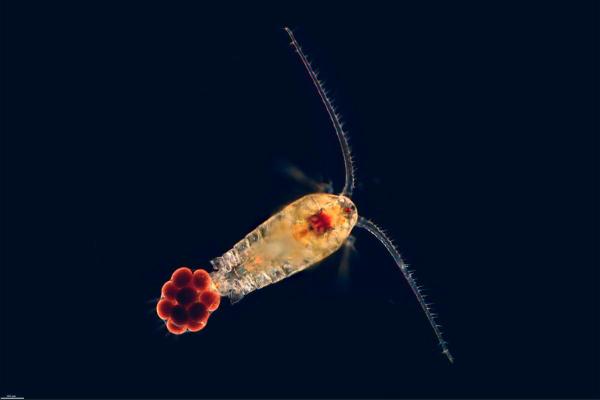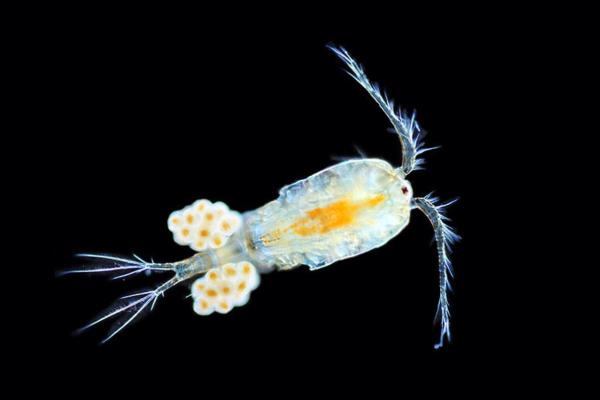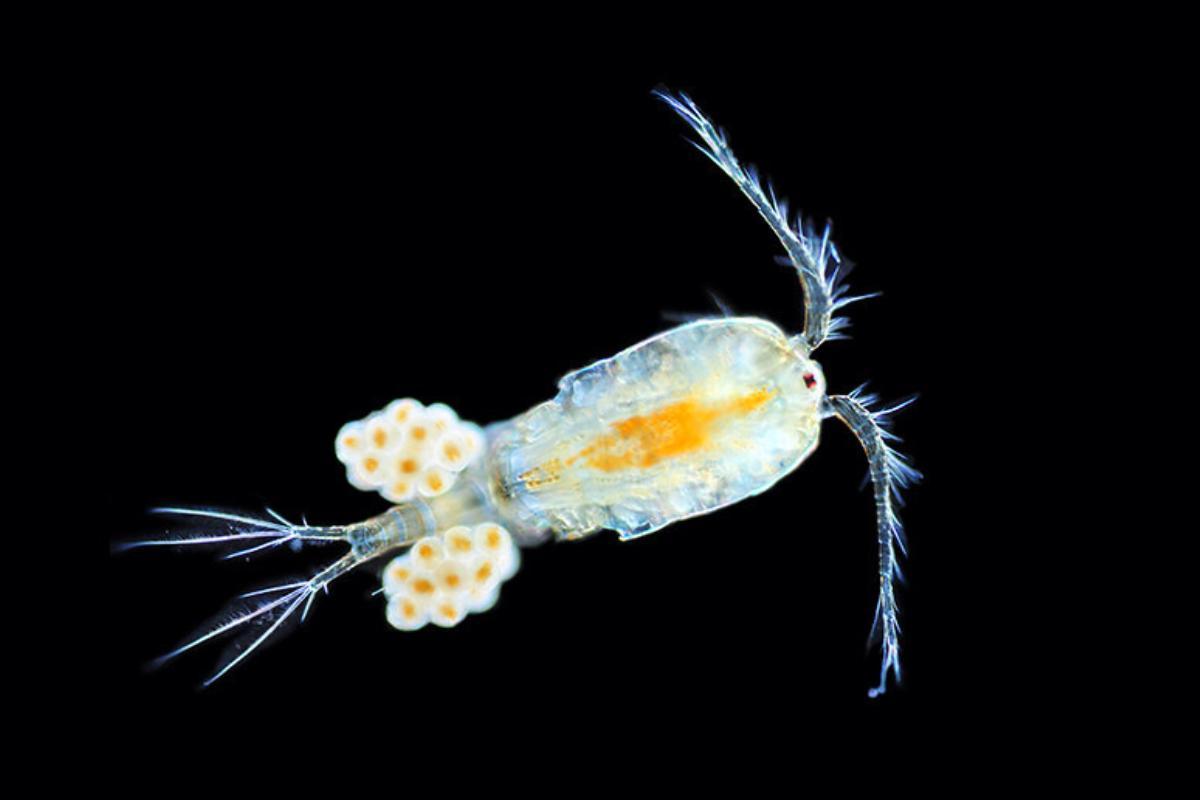What Are Copepods?


Copepods are tiny aquatic crustaceans that play an important role in the ocean food chain. They are considered one of the most abundant groups of animals on the planet and are found in virtually every aquatic environment, from freshwater lakes and rivers to the depths of the ocean. Copepods are an essential food source for many marine organisms, from small zooplankton to large whales. These small creatures come in a variety of shapes, sizes, and colors, and their adaptability has led to the creation of thousands of species.
In this article from thedailyECO, you will learn what copepods are, what their characteristics are, and which species are most common in different aquatic environments.
Characteristics of copepods
Copepods are small aquatic crustaceans belonging to the subclass Copepoda. They are found in both freshwater and marine environments and are one of the most abundant groups of animals on our planet.
- One of the characteristic features of copepods is their distinctive body shape. They have a long, slender body with a single eye in the center of their head.
- Their bodies are covered with a hard exoskeleton, and they have several pairs of legs that are used for swimming and feeding. Copepods also have a pair of antennae that they use to sense their surroundings and find food.
- These tiny creatures are usually less than 1 mm long, although some species can grow up to a few centimeters.
- Copepods are known for their ability to adapt to a variety of aquatic environments. They are found in every type of aquatic habitat, from the surface waters of the open ocean to the depths of freshwater lakes and rivers.
- They feed on phytoplankton and other small organisms, and their waste products contribute to the nutrient content of the water.
- Copepods are an important part of the ocean food web and serve as the primary food source for many other marine organisms. They are also an essential food source for many commercially significant fish species, making them a vital part of the natural and human food chain.
- Copepods are one of the most abundant groups of animals on the planet, and their adaptability has led to the evolution of thousands of species.
Do not miss our article on what is an aquatic ecosystem.
Types of copepods
Copepods are a diverse group of crustaceans with thousands of species, and they can be classified into different orders based on their characteristics and habits.
In terms of association, they can be either free-living or parasitic.
They inhabit a wide range of aquatic habitats, including freshwater, saltwater, and brackish water, and can be found in various locations within their environment, such as planktonic, benthic, semiterrestrial, or interstitial.
Copepods are a highly diverse group of crustaceans that are abundant in various aquatic environments. They can be classified into different orders based on their distinguishing characteristics.
- Order Calanoida: they have very long antennae, are marine and free-living.
- Order Cyclopoida: their antennae are short. There are freshwater and saltwater, free-living and parasitic.
- Order Gelyelloida: they live in subterranean water of limestone formations.
- Order Harpacticoida: their antennae are very short. They are free-living and can live either in the plankton or be interstitial.
- Order Misophrioida: benthic habits, moving on the aquatic bottom.
- Order Mormonilloida: they are elongated and have a separation between the thorax and abdomen, giving the appearance of an articulated tail.
- Order Monstrilloida: the larvae are parasitic on gastropods and polychaetes, and the adults do not feed, even lacking a mouth.
- Order Platycopioida: their mandible and fourth appendage have silken combs.
- Order Poecilostomatoida: they live in the sea and are parasitic.
- Order Siphonostomatoida: they are parasites.

Where do copepods live?
Copepods are highly adaptable species, with a cosmopolitan distribution across the world's waters, thriving in a diverse range of salt concentrations and temperatures. They can be found in various habitats, including:
- Freshwater
- Seas and oceans
- Brackish waters
- Tropics
- Antarctica
- Alpine lakes
- Phytotelmas, which are water-filled cavities inside terrestrial plants.
Some copepods inhabit zooplankton, a group of microscopic animals that drift at the surface of the water column. Free-living copepods constitute a significant portion of zooplankton, comprising 50% of the oceans and 96% of inland waters.
What do copepods eat?
Copepods exhibit various feeding strategies that depend on their species. Some examples include:
- Free-living copepods: These copepods can be filter feeders that use their antennae and maxillary appendages to create water currents and capture small particles that form plankton. Some species can also be active predators that actively hunt their prey.
- Parasitic copepods: These copepods live in the tissues or gills of animals, such as fish, mollusks, or whales. Their relationship with the host can either be commensal, where it does not harm the host, or parasitic, where it inflicts damage on the animal on which it feeds.
You may also be interested in this other article, in which we explore the question of how much of the earth is covered by water.
How do copepods reproduce?
If you're interested in the reproductive cycle of copepods, be prepared for a fascinating but complex process.
To mate, the male copepod uses its modified antennae to grab the female and transfer a gelatinous sac of sperm for fertilization. While some species release their eggs directly into the water, the female copepod usually holds the fertilized eggs until they hatch and provides them with the necessary care.
Once embryonic development is complete in the egg, a nauplius larva hatches. This is an early stage of the copepod with no abdomen, only a head and tail.
Through several molts it gradually grows until it reaches the copepod larval stage, but it is not yet fully developed as it lacks some limbs and abdominal segments. After a few more molts, it eventually becomes an adult copepod.
This interlarval development process can take anywhere from a few weeks to a year.

Why are copepods important?
Copepods are important in many ways. They play a critical role in aquatic food chains and serve as a major food source for many organisms such as fish, whales, and seabirds. They also help control algal populations by grazing on them, which can prevent harmful algal blooms.
In addition, copepods are used extensively in aquaculture as a food source for farmed fish and shrimp. They are also important indicators of water quality, as their abundance and diversity can reflect changes in the aquatic ecosystem.
In addition, copepods have been the subject of extensive scientific research due to their unique characteristics and diverse ecological functions. They have been used in studies ranging from biogeochemical cycling to evolutionary biology and have contributed significantly to our understanding of marine and freshwater ecosystems.
If you want to read similar articles to What Are Copepods?, we recommend you visit our Wild animals category.
- Suárez, E., Velázquez, K., Ayón, M. (2021). Catalog of copepods (Crustacea: Copepoda: Calanoida and Cyclopoida) of temporary water bodies of Jalisco . Mexico: The College of the Southern Border.







